A few years ago when visiting the Arcade I found a large print of a painting by an artist I had admired for many years. The artist was Adolphe William Bouguereau and the painting was called The Bathers. Whilst I did not purchase the work as I did not have the wall space to hang it, I was quite happy to see the painting again. Essentially the painting shows two naked women (sisters perhaps) on a rocky beach. Judging by their hair it does not appear that they have been swimming. One of the women is climbing on to a rock whilst the other sitting on a white towel staring into the middle distance. Whilst the subject (nudity on a beach) cannot really be described as being that erotic, the way the artist presents the women is very sensual.
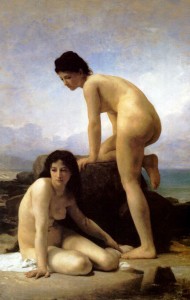
The Bathers, Bouguereau 1884
Neither of the women have by modern standards great figures. The model that is standing has quite heavy hips and quite a large bottom. Although seated her companion also shows a similar figure and it is this ordinariness that makes the work so erotic.
Although static it appears that the viewer has stumbled upon the women. But the viewer has not invaded their privacy and it is unlikely that they will share the fate of David who spied on Bathsheba having a bath on her roof. You are invisible. The artist wants you to share the women’s nudity (which is not explicit by any means). You are meant to feel comfortable as you stand in the gallery looking at his work. This is a good example of Victorian eroticism and Bouguereau was by no means the only artist to paint in this manner. Alma-Tadema, Frederic Leighton and John William Waterhouse were just a few of the large number of artists who painted the nude (or the costume nude) in an erotic manner.
During my time in Manchester I was lucky enough to have been able to study Waterhouse’s Hylas and the Nymphs at first hand and make a number of (very poor) compositional sketches. It is an intensely erotic work but does not deal with an everyday subject as Bouguereau’s work did. Whilst you might come across two women naked on the beach it is unlikely that whilst walking in the woods you would come across seven nymphs inviting you for a fatal swim. Obviously Waterhouse is using as his subject matter a tale from antiquity, but its presentation is obviously erotic. The nymphs unlike the women in the Bouguereau painting are not shown fully nude. Only two of the nymphs actually expose their breasts. But the eroticism is very powerful. This time the artist challenges you to imagine what you cannot see.
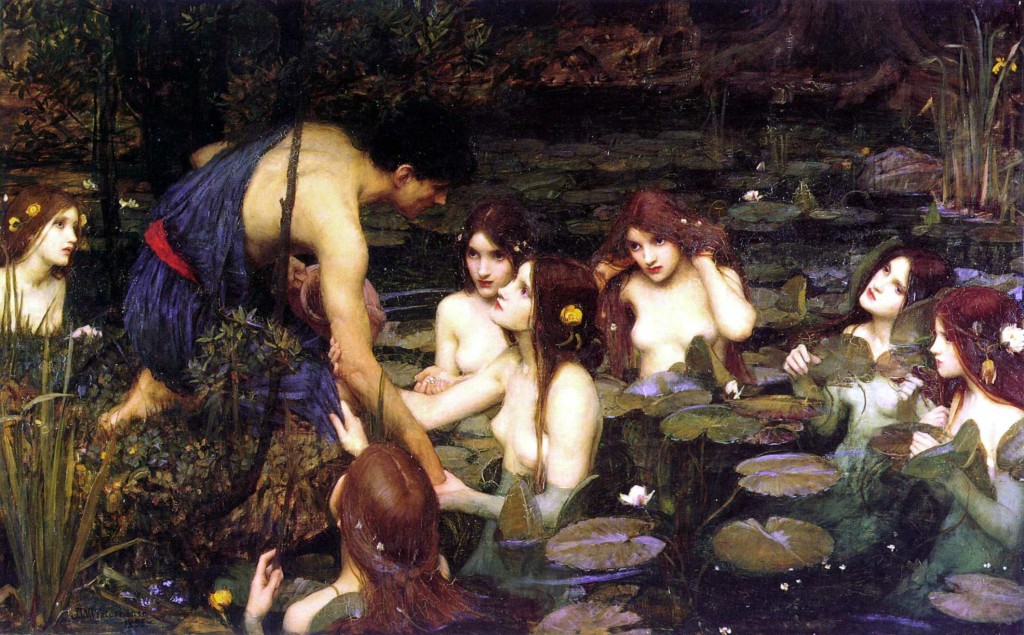
Hylas and the Nymphs, John William Waterhouse
Unlike The Bather’s the women represented in the work are a little too perfect. They are the ideal of the male imagination. They are quite slight with small breasts unlike the models in the Bouguereau work. Hylas does not stand a chance as he is going to be seduced and soon destroyed by the beauty that confronts him.
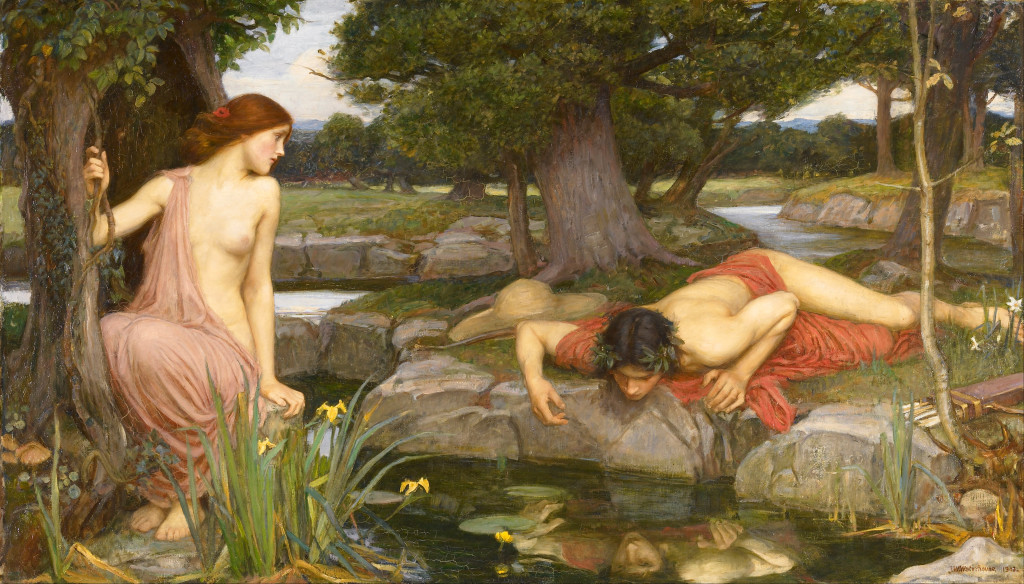
Echo and Narcissus
I have chosen these two paintings as illustrations because I actually purchased a copy of Hylas and the Nymphs along with a companion work Echo and Narcissus from the Arcade at about the same time that the Bouguereau work was for sale. They both hang quietly on the walls of our cottage.
I have noticed that the Arcade and other antique shops in the area have quite a large number of examples of what can be loosely termed Victorian Erotica. To modern eyes these works, whether they are paintings, etchings, sculptures or early photographs seem trite and lost in history. Nudity no longer shocks us as it is common in mainstream cinema, in magazines and even on the beach. We are no longer shocked by the unclothed as our Victorian ancestors were. But is that really the truth?
I read recently that Gustav Courbet’s L’Origine du monde was still causing ripples some one hundred and fifty years after it was painted. In 2011 somebody downloaded the work on to their Facebook page and it was subsequently disabled by the great and politically correct, which in turn led to a complaint from the user and a general fuss. I have seen the painting in the Musee d’ Orsay in Paris and although it is not one of my favourites it is indeed a powerful work. It is by no means pornographic as some would have you believe just graphic and quite erotic. The fuss over Courbet’s work does illustrate the double standards we have today. We like to think we are liberated and have an unfussed view of the world but this is not really the case. I have found that a number of people look down their nose at Victorian Erotica, even here in leafy Hungerford!

Art Nouveau Lamp
If one walks around the Arcade it does not take long to find an example of the genre whether it is an Art Nouveau table lamp or just an erotic sculpture of the period. I can remember one or two comments made when The Bathers was for sale. Vulgar and unreal was one I heard at the time. And recently when a Sapphic bronze sculpture was on display in the Arcade (I am not sure if this was actually Victorian) I heard the comment that the work was a pure male fantasy. Whilst I disagreed with the comment it amused me as there was an element of truth in it.

Female Nude Sculpture
Victorian Erotica was fully directed at the men of the period and there is no hiding that fact. The most important thing to the Victorian Gentleman was his respectability, his outward appearance, his place in the community. If he lost any one of these then they would be hard to regain if not impossible. And this is where the erotic came in as there was nothing wrong with a gentleman having a classical painting hung in his family house. Depending on the family it would show that the gentleman was modern in his thought and forward-looking. He was still respectable but appreciated the finer things of life be it a painting or a sculpture or the like. I am not saying he would have hung a reproduction of L’Origine du monde on his wall but an Alma-Tadema, Leighton or Waterhouse would have been most acceptable. He would have been able to have erotic works of art in his house and these would have been accepted.
Looking at it from today’s perspective we might take a more cynical view. The average man is attracted to the female form. It gives a man pleasure to see a woman unclothed. And this was the true reason that the average Victorian gentleman might have had these works in his house.
The erotic was very popular during the Victorian era and because of this, artists, sculptors, photographers and writers satisfied the demand. Whilst the average Victorian gentleman would not collect pornographic images (and there were just as many of these around during Victorian times) it was not frowned upon if he collected erotica. Maybe he would not have been as daring as Richard Monckton Milnes who was known to have had a large library of the erotic and was the possible creator of The Rodiad a rather graphic poem on the subject of flagellation. But I think our respectable gentleman might have considered some of Aubrey Beardsley’s more erotic works (maybe the Lysistrata series). He might have secreted these away to share with close male friend over port and cigars and this where to some extent photography came in. Photograph’s are quite small and can be easily hidden so our gentleman may have also had a collection of erotic photographs.
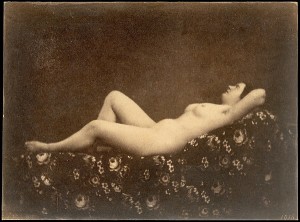
Female nude reclining by Julien Vallou de Villeneuve c. 1853
Although Fox Talbot’s early negative taken of a latticed window at Lacock Abbey in 1835 is generally thought to be one of the earliest exposures of its kind it did not take long for the nude to appear in photographs. A French artist named Julien Vallou de Villeneuve was known to have taken nude photographs in the 1850s although there is evidence that photographs of this nature were taken over ten years earlier. However it was not without its risks as a photographer named Felix Moulin was actually imprisoned for a month for obscenity in 1854. Photographic images of naked women increased rapidly in popularity and because of this the photographs became easier to obtain and this is the main reason so many survive to this day.
Recently I was in Marlborough and purchased a nude photograph dated, I would imagine, about 1880-1900 judging from the props
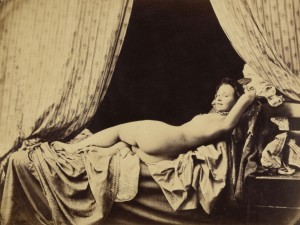
Photograph of reclining nude by Félix-Jacques-Antoine Moulin 1856
displayed with the model. By today’s standards it would not be seen as shocking. The model (who appears to be foreign) is full frontal naked and is standing in a somewhat stiff pose. The props just add to the formality of the work. She has her right hand touching the uppermost flower in a vase of flowers and she is partially leaning on a high-backed chair. But what is slightly different with this work is that the photograph shows the models pubic hair. Today that is not unusual as we expect to see pubic hair. But a large number of photographs in the Victorian era had the body hair removed. I have read various arguments about this. One that the removal of the body hair represented the classical ideal. It appears that in Classical Greece that no-one had pubic hair which is obviously nonsense. Other arguments state that the reason for this was just down to censorship. For some reason the authorities did not consider the exhibition of pubic hair appropriate.
This said have you noticed that even today photographs in some newspapers (usually the more popular ones) are still censored. The pubic regions of naked people (usually streakers or the like) are covered with a smiley face or something similar. It appears that certain people still think that pubic hair when shown in newspapers is going to corrupt the morals of the average man in the street. I do not think the average man in the street really cares. Indeed the artist Goya was criticised for showing pubic hair in his painting La Maja Desnuda painted between 1797 and 1800.
Pubic hair or no pubic hair these photographs are easy to find and cheap to collect. I paid a couple of quid for the one I found in Marlborough and I have seen the postcard sized ones even cheaper than this. My gentleman may have collected these and kept these locked in a drawer with maybe a copy of Swinburne’s poetry or a Richard Burton translation. It was a gentleman’s secret. I do not collect Victorian Erotica although I am fond of it as it is a window into the past and to some extent a social commentary.
As I am writing this I am looking at my Victorian nude and wondering who she was and what happened to her. Did she model out of necessity or was this her profession, an artist’s model maybe? As I have noted she looked to be possibly Italian or Spanish or maybe from the South of France. I wonder what she felt standing there in front of the photographer? Was it just another day at the office? Was the studio heated as the model looked a little cold?
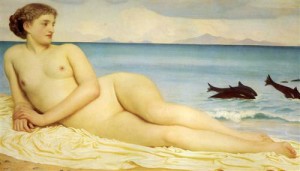
Actaea, the Nymph of the Shore, Frederic Leighton 1853
I am really attracted to the works of Lawrence Alma-Tadema, Frederic Leighton and John William Waterhouse and many others of the period. Given more space on my walls I would hang more reproductions of their work. But I will have to make do with my two Waterhouse prints but that need not stop you as there are many opportunities to purchase Victorian Erotica should you wish to.
There are a number of examples in the Arcade and in other antique outlets in the area. Price wise it is up to you to decide. The Bouguereau print was twenty pounds which was a good price. My Waterhouse prints were six pounds each which I was happy to pay. If you find a sculpture then expect to pay considerably more although some of the Art Nouveau lamps may be attractively priced. Postcards and the like are usually generously priced as are prints. As I have noted it is up to you what you consider a fair price to be.
What fascinates me is the social history of this genre and the attitudes then and now. I am in the process of framing my photograph and hanging it in my study but would not expect visitors to pass comment on the subject. Whereas the gentleman would have most likely have hidden the photograph in a locked drawer. Attitudes have changed, although not as much as people would lead you to believe. The media is still quite heavily censored and a sure way for a celebrity to advance her career is to remove her clothes or do something as daring. We have changed but not by that much. The Courbet painting still shocks some people and quite often things are censored without us really noticing or maybe really caring.
Whilst researching this article a couple of amusing facts came to light which I would like to share with you. In the Bouguereau painting two women are shown bathing in the nude which would have been commonplace before let’s say 1837. It was considered the norm to swim naked and both sexes participated although the fairer sex were more discreet. I read somewhere that near Weymouth it was common for large numbers of men to watch the local women bathing in the sea from a small cliff. This was until a local entrepreneur decided to purchase the vantage point and then charged the men a small fee for their enjoyment. I wonder if this man in later life decided that as bathing machines and full length costumes were the norm that he might invest in selling kinds of Victorian Erotica to a willing market. It would have been a sensible move and very much of the times.
The second fact concerns the Waterhouse work which I have studied quite closely over the years. It was only when writing this article that I noticed that all seven nymphs were in fact the same model. It is often said that one does not see what is right in front of one and this was definitely the case with this painting.
Happy Hunting.
Stuart Miller-Osborne